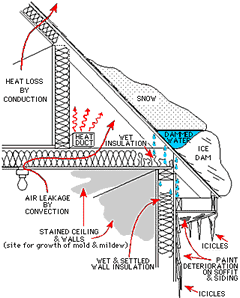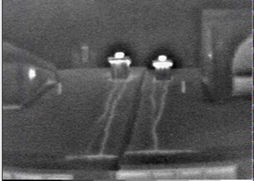|
||||||||||||
|
||||||||||||
|
|
Back to Building Envelope Theory Topics Ice DamsWhat they are and how they start
An ice dam is an accumulation of ice along the edge of a roof that does not allow water to run off the roof. Heat loss through a roof can cause snow to melt and the water to run off towards the roof overhang or the valley between two adjoining roofs. Once water hits the uninsulated and colder overhang or valley, it can refreeze. When this process happens enough times, a dam of ice builds up, and the roof has no drainage. Subsequent water run-off hits the ice dam and backs up underneath the roof shingles. Once water is under the roof shingles, it can penetrate the roof sheathing and cause leaking. CausesIce dams start with heat loss from a building’s roof. The heat loss can be attributed to several different factors: Air and vapor leaks from the inside through recessed light fixtures, fan units, chimneys, and other openings in the building envelope. These air leaks are often started when warm air rises, which causes the upper floors to be under positive pressure. Air under positive pressure will move or ex-filtrate to areas of lower pressure. This is commonly called the stack effect.
Using foam as part of the solutionThe best way to prevent ice dams is to stop the heat loss that causes the snow to melt and refreeze near the roof overhang. This can be accomplished by:
For more information on ice dam solutions visitMore information, case studies, and reports
ReferencesBynum, Richard, 2001. Insulation Handbook, McGraw-Hill, New York, NY. Lstiburek, Joseph and John Carmody, 1993. Moisture Control Handbook, Van Nostrand Reinhold, New York, NY. Lstiburek, Joseph, 1998. Builders Guide: Cold Climates, Building Science Corporation, Westford, MA. | ||||||||||
 |
||||||||||||





